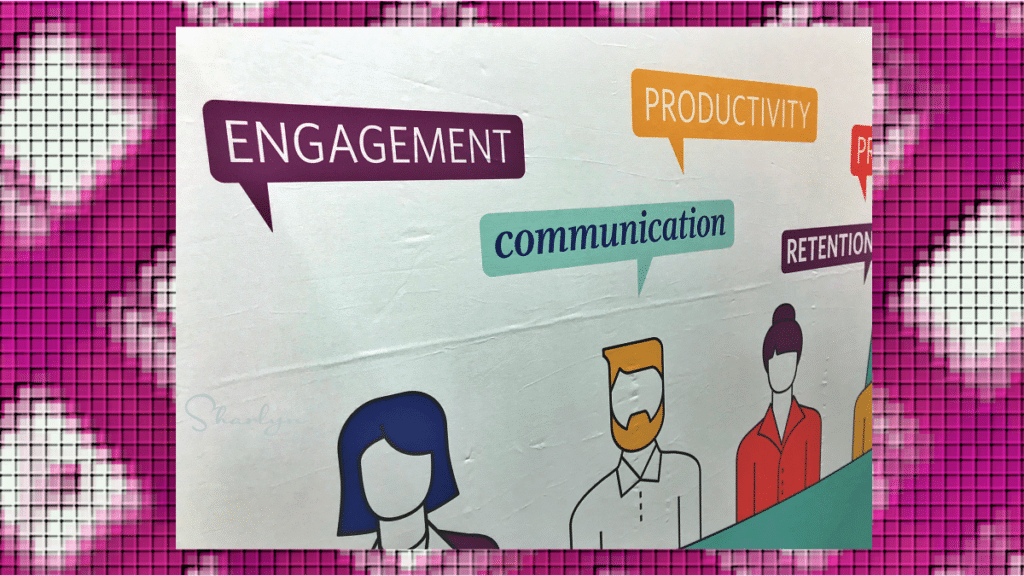Estimated reading time: 8 minutes
Personal story: Mr. Bartender and I have been trying to plan a little day trip for a while. We had a date and location all picked out. Then the Delta variant started dominating the news and we decided against it. That’s fine. We’ll get to go on that day trip in a few months. But it was a reminder that when it comes to COVID-19, one of the challenges we might be experiencing on a personal and professional level is how to deal with the constantly changing information.
My guess is we’re not alone. It can be fun to plan road trips and stuff. And the same applies to business. Organizations want and need to plan. Over the past couple of weeks, we’ve heard about several organizations revising their plans to welcome employees back to the office. It’s really hard on everyone to make plans when things are changing all the time. Unfortunately, I don’t know that this situation is going away any time soon.
To offer us some tips and resources for communicating during this time, I’ve asked back my friend Carrie Cherveny to offer her insights. Carrie is senior vice president of strategic client solutions in HUB International’s risk services division. In her role, Carrie works with clients to develop strategies that ensure compliance and risk mitigation when it comes to insurances such as health and welfare programs and employment practices liability.
Also with us is Meagan Tyson, senior vice president and national director of employee communication and design for HUB International. Meagan is responsible for leading and developing a team of strategists, designers and writers that creates dynamic and effective employee communication campaigns. Under Meagan’s leadership, the HUB Communications Team has been the proud recipient of the highly coveted national MarCom Awards for nine years in a row, including 2019.
Just a quick reminder that today’s article shouldn’t be construed as legal advice or as pertaining to any explicitly factual situations. If you have specific COVID questions, they should be addressed directly with your friendly neighborhood labor and employment attorney.
Welcome Meagan and Carrie! This first question is being debated all over the place, so let’s put it to rest. When we talk about COVID and workplace communications, one subject that regularly comes up is vaccinations. If an employer asks an employee if they are vaccinated, is that a violation of the Health Insurance Portability and Accountability Act (HIPAA)? And as a quick follow-up, if a co-worker asks if you’re vaccinated, is that a violation of HIPAA?
[Cherveny] The short answer to both questions is no. HIPAA and employee medical information are not synonymous. In fact, employee medical information is only Protected Health Information under HIPAA in very limited circumstances. Medical information gathered through the Family and Medical Leave Act (FMLA), Americans with Disabilities Act (ADA), disability insurance, workers compensation, or other sick-leave documentation is generally not protected under HIPAA but is confidential under the ADA. The ADA provides that employee health and medical information is highly confidential, only those who ‘need to know’ may have access to this information, and it must stored separately in a secure medical file.
While HIPAA can be a complex law, in a nutshell, if the employer learns of the employee’s medical information, condition, diagnosis, etc. through the health plan, or as the employee’s own healthcare provider (for example, a hospital or doctor’s office that administers the vaccines to its own employees) then that information is likely protected under HIPAA.
Otherwise, HIPAA obligations generally manifest themselves most frequently in employers with a self-funded health program that have access to claims information. Self-funded programs include health flexible spending arrangements (FSA) and health reimbursement arrangements (HSA). However, employers that receive employee’s explanation of benefits (even if fully insured) may unintentionally subject themselves to HIPAA. HIPAA also generally prohibits an employer from discriminating against an employee who has a medical condition.
The Centers for Disease Control (CDC) have been regularly updating their guidance on masking. I think this might be something we’re going to continue to see in the months to come. What should organizations do when they hear about changing guidelines?
[Cherveny] The guidance and guidelines are evolving and changing, sometimes on a daily and weekly basis. I will share two of my not-so-secret “secrets” which have proven to be very helpful over the last 18 months:
- Bookmarks! Several agencies have news update pages that you can bookmark and check frequently.
Individuals can sign up to receive alerts from each of these government agencies which will be tremendously helpful.
- LinkedIn. My second not-so-secret ‘secret’ is LinkedIn. I have a group of attorneys that I’ve known for years, trust, and follow. These are attorneys who research and read cases and regulatory changes daily and share their findings with us on LinkedIn. Find your trusted resources, follow them, and then follow up with your own research.
Obviously, employees are going to hear about COVID-19 updated guidance in the news. And they will naturally wonder what the company’s position is on it. Can you offer a few suggestions on how organizations should communicate changes to their employees?
[Tyson] The organization should communicate any new policies or updates to existing company policies as soon as those decisions are made. Transparency is key. The update should come from leadership and should include a statement on why the changes are being made and where employees can go with questions or to find more information. It is also important to inform local management prior to the communication going out so that they are prepared to respond to employee feedback. These communications can be emotional for many people, so make sure to only cite credible sources and stick to the facts.
Some organizations might evaluate the situation and decide not to make any operational changes. Is there a good way to tell employees that “we’re not making any changes”?
[Tyson] As soon as a decision is made, communicate it, from leadership to your organization. Provide insight on why your policy is remaining as-is and where employees can go to ask questions or to find more information. If you are not going to implement mandatory masking indoors, a statement could read something like this:
“At this time, and unless a state or local regulation requires otherwise, we have decided to maintain our current masking requirements, which states that if you are fully vaccinated, you are not required to wear a mask in our offices but are strongly encouraged to do so unless you are seated at your desk with adequate social distancing or physical barriers between yourself and others. If you are not fully vaccinated, you are still required to wear a mask at all times, unless you are seated at your desk with adequate social distancing or physical barriers between yourself and others.”
Last question for both of you. If organizations can only focus on one thing right now – when it comes to communicating workplace safety – what should it be?
[Tyson] Facts! Don’t get into politics or the emotional aspect of COVID-19 and vaccinations. Keep communicating your strategy and policies, even if there are no new updates.
[Cherveny] In this time of great uncertainty, employers can provide employees much needed predictability. Transparency and employee safety are of paramount importance. Be sure employees know and understand that their safety is the organization’s top priority – that the company is making decisions based on safety and continued success of the business. Ensure employees know how to ask questions.
- Have you formed a COVID committee?
- Do you have individuals in the organization who remained informed and knowledgeable about COVID-19, OSHA and CDC guidance, and employee rights?
- Have you included trusted community and religious leaders in your employee communication?
Sometimes, hearing the information from trusted community and religious leaders may give employees a sense of comfort while dispensing myths and inaccurate information.
I want to extend a HUGE thanks to Carrie and Meagan for sharing their knowledge with us. COVID (and its variants) will continue to challenge us – even with vaccines in place. Don’t forget that HUB International is maintaining a COVID FAQ. This is a 200+ question FAQ updated regularly to consolidate the ever-changing and updated regulatory information across all aspects of employment including benefits, health and safety, and employee relations.
One of the first rules of effective communication is trying to have all the information so we can communicate accurately. But when we’re dealing with unprecedented times, we might have to bend that rule a little. The most important thing we can do right now is let employees know that we care, and we will communicate what we know – when we know it. Even if we don’t have all the answers right now.
Image captured by Sharlyn Lauby while exploring the streets of Boston, MA
The post How to Provide Employees Current COVID Information appeared first on hr bartender.





0 Commentaires